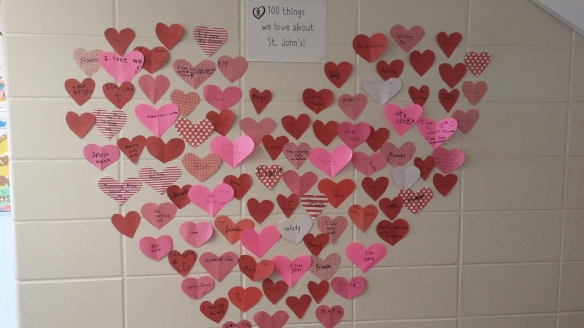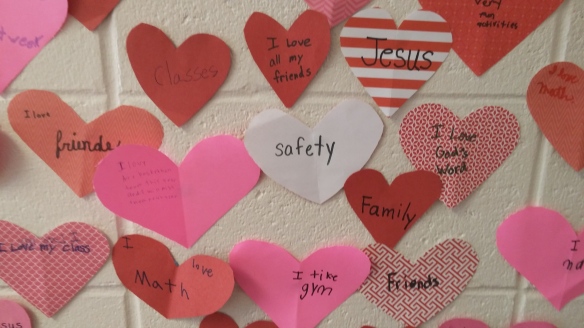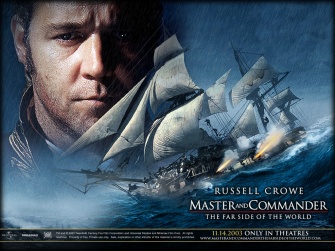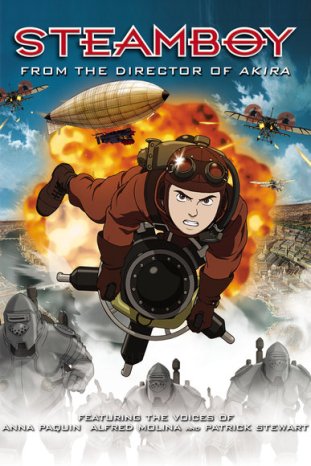I never linger in sight. Last time I did, Bash screeched his head off the entire march down the stairs from his classroom, and Biff nearly pushed the child ahead of him down the stairs. So I remain around the corner where a small corridor leads to the church’s daycare.
February holds two major events for an elementary school: Valentine’s Day, and the 100th day of school. I don’t remember celebrating the 100th day as a kid, but Blondie assures me this is a big deal that requires special games and treats all revolving around the number 100. O-kay.
The boys’ school was in the spirit, too. I couldn’t stand far enough away to get a complete shot, but I was able to take a few close-ups.

I loved studying the variety of writing styles, of what must have come from adults vs. tweens, of kids vs. teeny ones. And the choices made in both topic and writing fascinated me. Take that pink heart in the bottom photo–why history? And why write it with the teensiest letters possible? One seems to enjoy her cursive “friends” (because I’m guessing a boy’s not going to change font, let alone write the cursive so carefully), while another is equally writing friends so long as it can be in nearly invisible red ink. Two kids apparently like Spirit Week, though one’s definitely younger than the other…
I love the creativity little ones put into spelling words they don’t know, with letters big and proud. And then you have some who wrote at a weird angle–why? And one who really digs the teacher but must have forgotten how to spell her name, so a few letters had to go above the “Mrs.” Then, of course, there’s the over-achiever who had to explain why she picked what she did, and needed to make extra hearts to emphasize her love for it.

Yes, being a Christian school, there were bound to be a few God-related hearts. But the heart in white is the one that really got my attention.
Bo’s certain it was written by a grown-up, but I’m not so sure. I studied that heart quite closely compared to the others, and the letters are a bit stilted and crooked when compared to the other more rounded, brighter teachery lettering.
The political climate of the United States has become a nightmare for many. I’m not going to lie–Wisconsin feels very cut off from it all. Milwaukee’s always been racially tense, Madison’s always been loudly liberal, but the rest of the state is, well, quiet. It can be easy to forget such a basic want is still very much a want everywhere: to be safe. To be where one is wanted, protected, and loved.
Every heart shares a piece of life tied to that school. I look upon how these words are rushed, curled, misshapen, stiff, and cannot help but wonder what else is tied to these hearts. That if I were to pick a heart from the wall I’d find a string, a string leading up and down stairs and around the playground and back into the room where the heart’s maker sits. I’d look upon the maker, tied to all the scraps and bits of life that brought the heart maker to write that word above all words.
And I’m betting I’d find a story.







 Some stories cannot be told with crashing-techno, happy pop, or lonely piano. Some stories call for the drums of battle.
Some stories cannot be told with crashing-techno, happy pop, or lonely piano. Some stories call for the drums of battle.